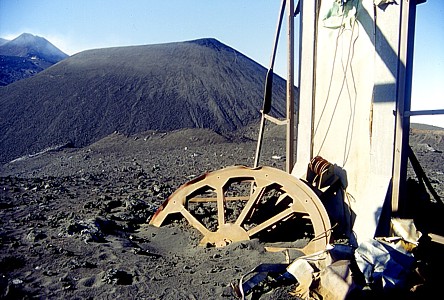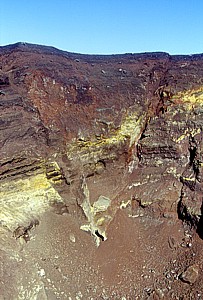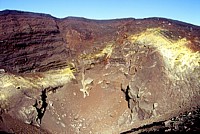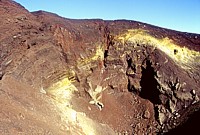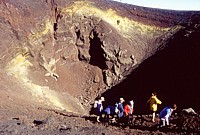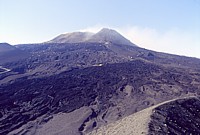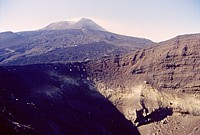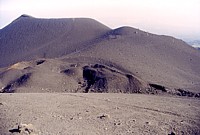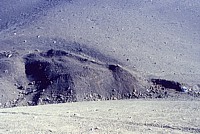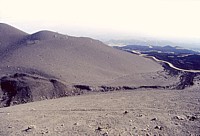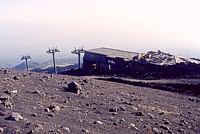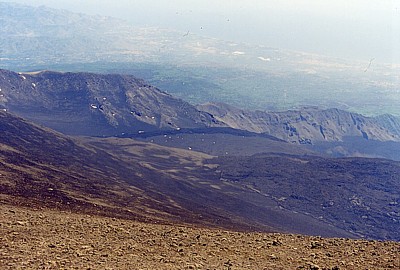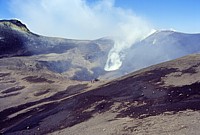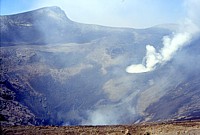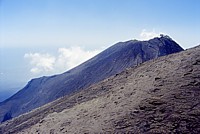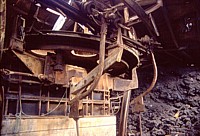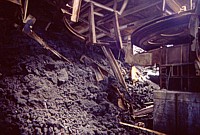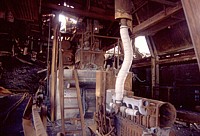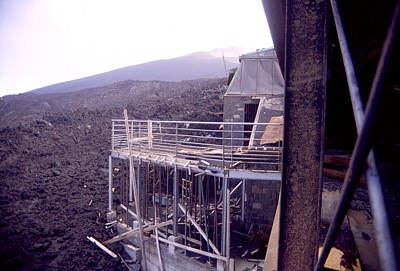 |
Spring 2002,
time for excursions to the volcano, whose morphology has been dramatically
altered during the eruption in July-August 2001. Scenes of utter devastation,
and a dozen of small and large morphological features had been added to
the landscape of Mount Etna's southern flank, and to a lesser degree to
its northeastern flank (where more dramatic changes would occur later
in 2002). I made four visits to these areas in May-October 2002, documenting
photographically most of these features, before many of them vanished
forever in the 2002-2003 eruption.
Mount
Etna's violent baby, 28 July 2001, and revisited, 29-30 May 2002
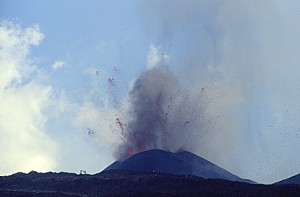 |
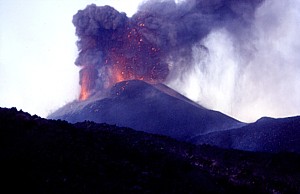 |
These
spectacular scenes are some of the most impressive moments during
the growth of that enormous new cone at about 2570 m elevation
(pre-eruption surface is reference), immediately to the north
of the Montagnola. The photographs are placed here to illustrate
the violence of the activity at this site, which in this form
lasted only for six days. Flashback: activity at this site began
on the afternoon of 18 July 2001, 40 hours after magma broke through
the surface some 500 m further downslope and 1.5 km to the south.
For one week, until 25 July, the activity there was phreatomagmatic
(that is, characterized by the explosive interaction of the rising
magma with a shallow aquifer) and no cone was built. Then, on
25 July, the activity became magmatic, and now a cone began to
grow very rapidly, due to constant powerful explosions whose noise
could be well heard as far as Catania, 25 km away, at rush-hour
(!). The climax of activity was on 28 July, when these photographs
were taken from only a few hundred meters away (the detonations
caused by the explosions would make your ears hurt at that distance).
Four days later, the activity diminished notably, and no further
significant growth of the cone occurred, which by this time was
about 100 m above the pre-eruption surface |
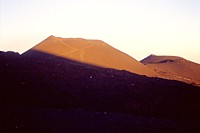 |
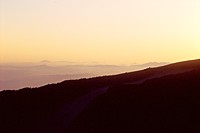 |
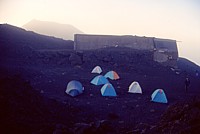 |
Daybreak
on 30 May 2002 has a feeling of eternity in a place that was dramatically
altered only ten months earlier, and which would undergo even
more dramatic changes five months later. These photographs were
taken at the ruin of the second-generation (post-1971 until 1983)
arrival station of the cable car, located somewhat higher upslope
than its successor (which was destroyed in 2001) and shown in
the right-hand photograph. Left image shows Monte Josémaria
Escrivà from that location, with the Montagnola in the
distance at right. Center photograph is a view to the Madonie
mountain range, nearly 200 km to the west. The right photograph
shows the tents of an excursion group that slept near the ruin
of the pre-1983 arrival station of the cable car, and Monte Josémaria
Escrivà is seen in the left background.
What is so peculiar about this place is that it vanished without
a trace during the 2002-2003 eruption on the southern flank. The
lowermost of the new vents formed exactly in the place where the
tents and building are standing in the right-hand photograph (see
how this
place looked like at an early stage of the 2002-2003 eruption).
By pure coincidence I was with the last excursion group to sleep
in that place, exactly one week before the beginning of the 2002-2003
eruption. At that time, there was virtually nothing that would
have indicated a major eruption only one week later |
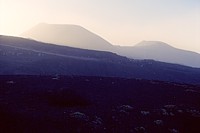 |
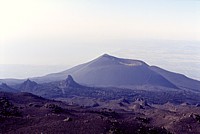 |
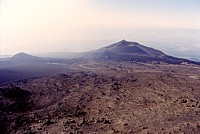 |
These
photos are history. It will never again be possible to take the
same photographs, because the places from which they were taken
have disappeared, and with them have some of the features seen
in these images.
Left: the rising morning sun of 30 May 2002 casts a golden hue
onto the strikingly similar (from this perspective) cones of Monte
Josémaria Escrivà (left) and the 238 years older
Montagnola (right). Seen from the pre-1983 arrival station of
the cable car (now deeply buried below the lavas of the 2002-2003
eruption)
Center: two prominent steep-sided spatter cones (hornitos) are
seen in the left foreground, marking the lowermost portion of
the second fissure that opened on the first day (17 July) of the
2001 eruption, at about 2690 m elevation. Interestingly, the magma
that fed these vents (as well as those higher upslope and closer
to the Southeast Crater as well as a small fissure on the upper
northeastern flank) came from the central conduit system of Etna
(the conduits that lead to the summit craters). The lower vents
on the southern flank, including those of Monte Josémaria
Escrivà (in the background, only about 1 km from the 2690
m vents), were fed from a different source. The area in the foreground
was buried by about 50 m of new pyroclastic material during the
2002-2003 eruption
Right: a panoramic view of what once was called Piano del Lago,
the Plain of the Lake. Where the lake used to form during the
spring snowmelt, there is now the huge cone of Monte Josémaria
Escrivà (seen in the distance at right, with the Montagnola
immediately behind it). A much smaller cone, only about 20 m high,
is visible at left, which has formed at about 2740 m elevation.
Monte Josémaria Escrivà is still there after the
2002-2003 eruption, but all other features that are seen in front
of it in the photograph at right have vanished without any trace |
Summit
visit , 30 May 2002
|
A
narrow streak of black lava marks the site of the northeasternmost
outpost of the July-August 2001 eruption, in the Valle del Leone,
seen here from the eastern rim of the Voragine (one of Etna's
four summit craters, and inactive since 1999) on 30 May 2002.
The northern wall of the Valle del Leone (which is a kind of side
valley of the Valle del Bove, further to the right) and of the
Valle del Bove is seen in the center of the image, and Etna's
northeastern flank with the Monti Peloritani and the Ionian coast
near Taormina in the background. The dark-colored lavas in right
foreground were erupted from the Southeast Crater in 2000 and
early 2001 |
The
museum that never was, June 2002
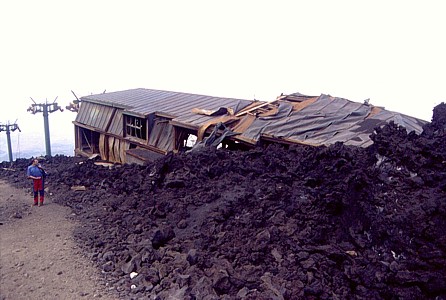 |
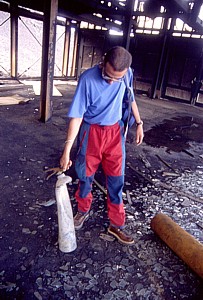 |
Etna
played an evil game with the cable car on the southern flank in
2001 (it did so again, this time not only with the cable car,
in late 2002). The cable car, or better say, the third-generation
cable car (two earlier generations had fallen victim to the eruptions
in 1971 and 1983), had just been fully renovated, and should have
been reopened in late July 2001, when the eruption began from
numerous vents on the southern flank. During the first nine days
of the eruption, it suffered little damage, but things changed
when lava began to issue from a vent on the southern base of the
cone later to be named Monte Josémaria Escrivà.
On 26 July 2001, a lava flow entered the arrival station of the
cable car from above, causing a fire in its upper portion (seen
at right in the left-hand image). Four days later, a small lobe
of lava surrounded the eastern side of the building (left) and
entered through the windows of the bar in the ground floor. This
caused a large fire, which burned all that remained inside the
building. However, the lava advanced just enough to set the structure
ablaze and then stopped without crushing it - and left a museum
to the posterior world. While the ruin was still standing (it
was broken down in September 2002 as work for the reconstruction
of the cable car and its arrival station was started; this was
interrupted a few weeks later by the new eruption), visitors would
find a never-ending quantity of objects of all kinds inside, such
as the useless fire-extinguisher that Giuseppe Scarpinati holds
in the right image |
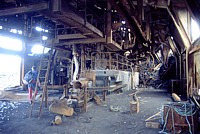 |
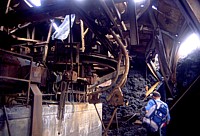 |
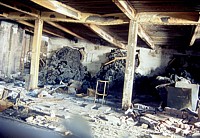 |
Before
the 2001 eruption, visitors to Etna who went uphill with the cable
car would, after a 20 minutes' ride, arrive in the main hall of
the arrival station of the cable car (seen after the destruction
in the left image). The cabins would stop right in the place shown
in the center photograph, and a staircase to the right led to
the ground floor of the building, where visitors had the chance
to buy souvenirs, have a sandwich, or drink a coffee, a juice,
or a beer, in the bar, which is shown in the photograph at right.
Note how the lava came in through the side windows of the bar,
forming three short lobes of equal length that stopped once they
had reached the floor. For many months after the eruption and
destruction of the building, a wealth of peculiar objects, including
numerous deformed bottles, could be found in this location. Someone
claimed to have found, shortly after the eruption, a few still-intact
bottles of wine amidst the devastation and said to have tasted
it, declaring that it was delicious |
|
Nearly
finished at the time the 2001 eruption began, a new terrace on
the western side of the building of the arrival station of the
cable car would have invited tourists to relax and tan in the
sun |
Continue
(next page)
Return
to the Etna photo gallery
|
![]()




